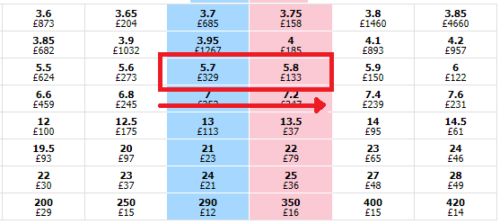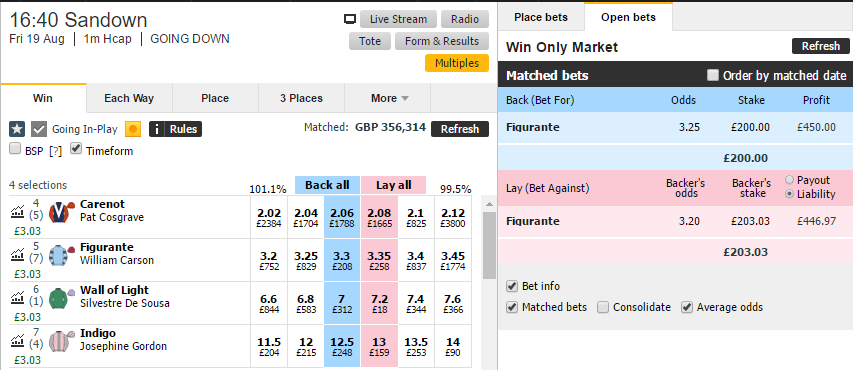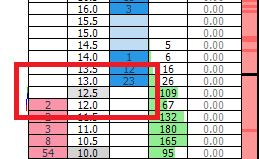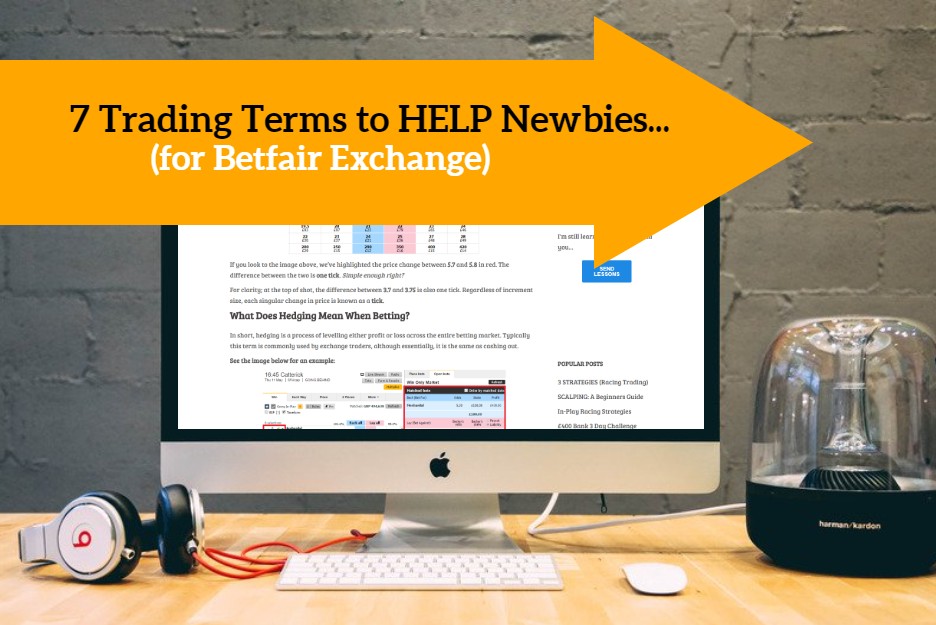With some of the trading terms that bounce around, the prospect of learning to trade can appear quite daunting to newbies.
In this article, we cover seven of the most common trading terms that newbies don’t understand.
Feel free to skip ahead…
Starting with the most common ones…
What Does Tick Mean?
A tick is an incremental change in the price on the betting exchange.

If you look at the image above, we’ve highlighted the price change between 5.7 and 5.8 in red. The difference between the two is one tick. Simple enough right?
For clarity; at the top of the shot, the difference between 3.7 and 3.75 is also one tick. Regardless of increment size, each singular change in price is known as a tick.
What Does Hedging Mean When Betting?
In short, hedging is a process of levelling either profit or loss across the entire betting market. Typically this term is commonly used by exchange traders, although essentially, it is the same as cashing out.
See the image below for an example:

To put this term into context, in the image above, we’ve hedged for a profit of £9.43.
This is achieved by betting at one price, and then betting against the same outcome at another price for a similar value. You can see on the right of the shot (bet slip) the differences in bet prices and stakes. To see how this ‘hedged bet’ is achieved, you should subtract the stake from backer’s stake and liability from profit (and include the commission).
This is where the term ‘hedge your bets’ comes from!
What Does Scalp the Market Mean?
Scalping is a rather slang term used by Betfair traders, which basically means the following:
“Scalping is a technique that relies on small, short term price changes within any betting exchange market.”
You can see a full explanation here in this article.
Although on the face of it, the process of scalping is quite simple. We’re looking to obtain a profit for the market over the space of one to two tick increments. This approach doesn’t necessarily require much understanding of the betting market and how it functions.

A quick look at this bet slip shows us that we managed to scalp out a quick profit between 3.25 price and 3.20 price.
The difference is one tick, and the bets are hedged. See what we did there?
What’s a Fill Rate?
Possibly an obvious one. The fill rate is the speed at which money is entering and flowing into the betting market. The bets that actively match money in the process. This is not to be confused with unmatched money or unmatched traded volumes.
If you use the Geeks Toy trading software you can see money ‘fill’ as it enters the market like this:

To be clear; £46 was filled at 2.70 as we took this snapshot.
Typically the fill rate of a market will increase closer to the start. It just makes sense as this is where most of the tradeable betting activity takes place.
Trading Term: Averaging Means…
To be honest, I’m not really a fan of this. But it’s a trading term that appears in many conversations online.
In some circumstances, averaging can be useful, but shouldn’t be a focus of interest for newcomers…
Averaging can be described as the process of adding to an already existing open trading position in order to offset the potential profit or loss margins.
For example: if we were to back at 6.0 and the price moved out to 6.4, we could average this price by backing the price again at 6.4.
See the image below:

Doing this, gives us an average price of 6.2 (highlighted by the red box on the right).
I’m not particularly a fan of this as often people do it when they can’t accept a loss. I wouldn’t want to encourage anyone into trying to average their way out of a mess, it makes no logical sense.
What is the Spread on Betfair?
The spread on a betting exchange can be described as the difference between both back and lay prices. It’s that simple.
If the market is highly fluid and the prices are butted up against each other, between say 4.5 and 4.4. The spread would be one tick increment.
However, if we have a low liquidity market – the spread may be higher. See this snapshot as an example:

The spread here would be two tick increments. Some might argue it should not even be viewed as that, because there is so little lay money available.
In short-bigger spread, the harder it is to get bets matched!
What Does Backing to Lay Mean?
Backing to lay is another slang term that traders use. You’ll see this in horse racing more than anything else. The suggestion is to back a horse prior to the start and lay it off early in the race. Mainly because the horse’s behaviour exhibits certain characteristics which will provide the potential for a quick profit. Therefore, backing it first to lay it off in running.
Outside of horse racing, you may have heard traders refer to this in football and tennis. When they say this they simply mean, backing first and laying off afterwards.
There’s a thorough article about back to lay on the blog here.
Are there any other trading terms you don’t understand? Add them in the comments and we’ll get this article updated for you!
Just Starting? See Betfair Trading Made Simple HERE


2 thoughts on “7 Trading Terms to HELP Newbies… (for Betfair)”
nice article, pls can you send me any profitable strategy i can use on betfair thanks.
Hello,
I’m writing in regards to fill rate. I’d be grateful if you can explain the fill rate and it’s significance as I have seen in my trading videos that traders look at fill rate to determine whether the rate would be going up or down?